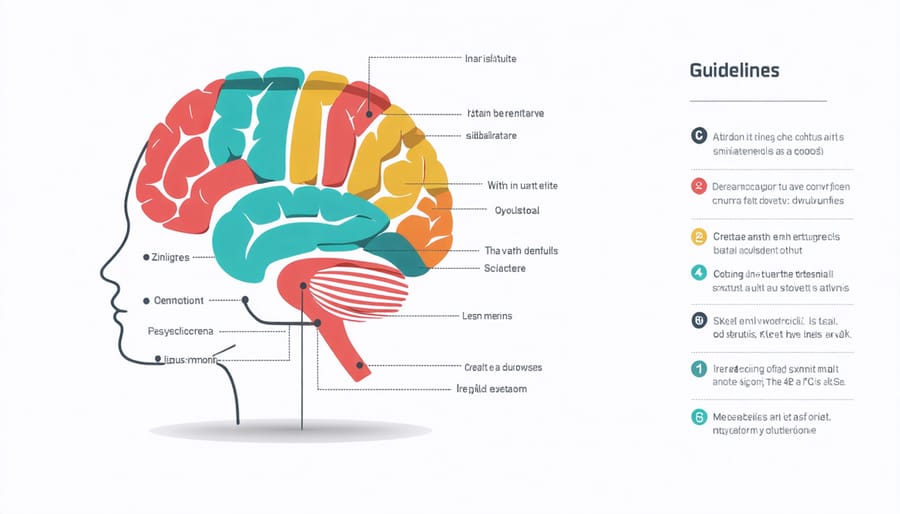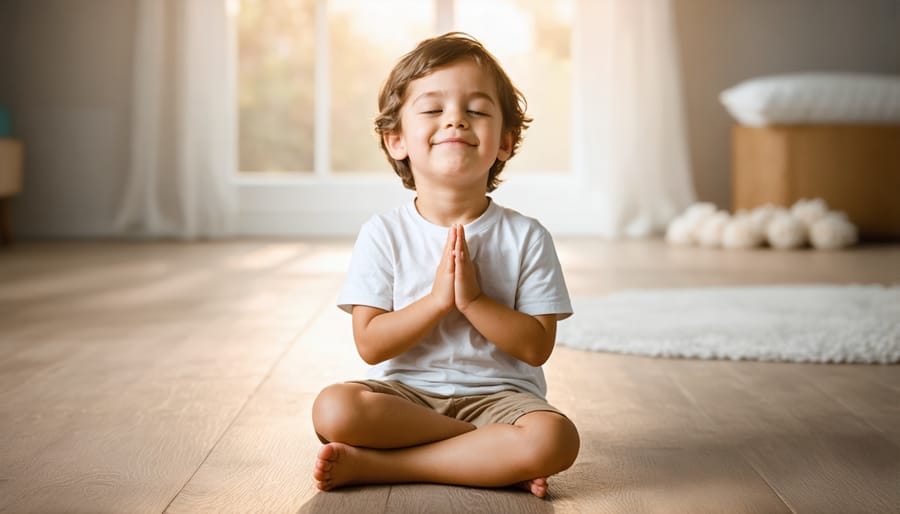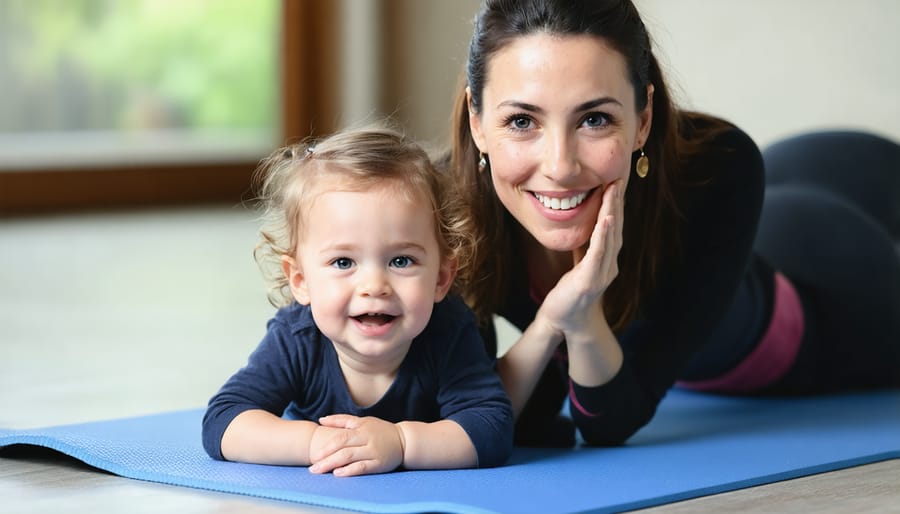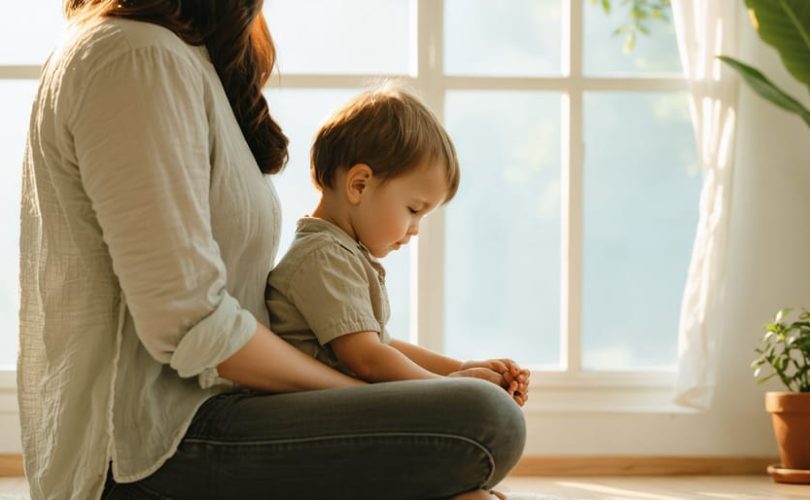Pause with your child for three deep breaths when emotions run high, creating a shared moment of calm that builds connection and emotional awareness. Guide your child’s attention to physical sensations – the rise and fall of their chest, the feeling of their feet on the ground, or the temperature of their hands – establishing a concrete foundation for emotional development in children. Transform daily routines into mindfulness opportunities by practicing gentle awareness during activities like brushing teeth, eating breakfast, or walking to school.
Children naturally experience intense emotions, but mindfulness offers a powerful toolbox for understanding and managing these feelings. Through simple, age-appropriate practices, young minds learn to recognize, accept, and navigate their emotional landscape with growing confidence. This skill set not only supports immediate emotional regulation but builds lasting resilience and self-awareness that serves children throughout their lives.
Research consistently shows that mindful children demonstrate improved focus, reduced anxiety, and stronger emotional intelligence. By incorporating these practices into family life, parents create a foundation of emotional stability that benefits the entire household, fostering deeper connections and more peaceful interactions.
Understanding Mindfulness Through a Child’s Eyes
What Mindfulness Means for Kids
For children, mindfulness means paying attention to what’s happening right now in a friendly, curious way. It’s like becoming a gentle detective of their own thoughts, feelings, and body sensations. When children practice mindfulness, they might notice the way their breath feels like ocean waves, how their favorite stuffed animal feels soft against their skin, or the sweet taste of an apple during snack time.
Young kids often naturally live in the present moment, but helping them recognize and name this awareness can become a powerful tool. For example, when a child stops to watch a butterfly or listens intently to rain falling on the roof, they’re already practicing a form of mindfulness.
Parents and teachers can introduce mindfulness to children through simple activities like “belly breathing” – where kids place a small toy on their tummy and watch it rise and fall with each breath. Another approach is the “five senses check-in,” where children name five things they can see, four they can touch, three they can hear, two they can smell, and one they can taste.
Remember that children’s mindfulness shouldn’t feel like a chore or another task to complete. Instead, it should be presented as a gentle, playful way to explore their inner and outer worlds.
The Brain-Emotion Connection
Our minds and emotions are closely connected, like a delicate dance that affects our daily experiences. When we practice mindfulness, we’re actually influencing how our brain processes emotions. Research has shown that regular mindfulness practice can strengthen the areas of the brain responsible for brain development and emotions, particularly the prefrontal cortex and amygdala.
Think of mindfulness as a gentle exercise for your brain – just like how we build stronger muscles through physical activity, we can build stronger emotional awareness through mindfulness practice. When children learn to pause and observe their feelings without judgment, they’re developing crucial neural pathways that help them manage their emotional responses better.
Dr. Sarah Thompson, a child psychologist, explains it beautifully: “When children practice mindfulness, they’re essentially training their brains to respond rather than react to emotional situations. It’s like giving them a emotional toolkit they can carry with them throughout their lives.”
This mind-body connection helps children develop better emotional regulation skills, reduce anxiety, and build resilience in facing life’s challenges.

Building Your Child’s Emotional Toolkit

Breathing Exercises That Actually Work
Learning effective breathing techniques for kids can make a huge difference in how they handle big emotions. Here are three simple exercises that children actually enjoy and can use anywhere:
The “Bear Breath” is a favorite among younger children. Have your child pretend they’re a sleepy bear in winter. Encourage them to take a long, slow breath in through their nose for 4 counts, hold it gently for 2 counts, then exhale slowly through their mouth for 4 counts. This naturally slows down their breathing and helps them feel calmer.
“Rainbow Breath” combines visualization with breathing. Ask your child to imagine drawing a rainbow in the air. As they breathe in, they raise their arms up in an arc, and as they breathe out, they complete the rainbow’s arc down to the other side. Each color can represent a new breath.
The “Hot Chocolate Breath” is perfect for anxious moments. Have your child imagine holding a cup of hot chocolate. They smell the chocolate (inhale through the nose), then blow gently to cool it down (exhale through the mouth). This exercise is especially effective because it’s both fun and practical.
Remember to practice these exercises during calm moments first, so they become natural tools when emotions run high. Gentle reminders and joining in the practice yourself can help make these exercises part of your child’s daily routine.

The Body Scan Adventure
Transform the traditional body scan meditation into an exciting adventure that captures your child’s imagination. Start by having them lie down comfortably on their back, perhaps on a soft carpet or yoga mat. Tell them they’re about to become explorers of their own body, discovering amazing sensations along the way.
Begin the journey at their toes, asking them to wiggle them gently while imagining they’re tiny sea creatures dancing in the ocean. Move up to their legs, describing them as strong tree trunks growing from the earth. Their belly becomes a breathing balloon that rises and falls with each breath, while their chest houses a warm, glowing light.
Make it interactive by asking questions like “Can you feel your heart beating like a friendly drum?” or “What does your breathing sound like – is it quiet like a whisper or strong like the wind?” When reaching their hands, invite them to imagine they’re holding something special – perhaps a favorite toy or a magical crystal.
For younger children, keep the experience brief (3-5 minutes) and use plenty of imagery. Older children might enjoy longer explorations (5-10 minutes) with more detailed awareness exercises. Remember to end the adventure by having them slowly wiggle their fingers and toes, gently opening their eyes when they’re ready.
This playful approach helps children develop body awareness while making mindfulness feel natural and fun rather than like a chore.
Mindful Play Activities
Engaging children in mindful play creates a natural bridge between fun and emotional awareness. These activities make mindfulness practice feel less like a task and more like an adventure. Here are some playful exercises you can try with children:
“Mindful Bubble Blowing” invites children to focus on their breath while creating beautiful bubbles. Ask them to notice how their breath changes when blowing slowly versus quickly, and how it feels watching the bubbles float and pop.
“Weather Report Check-In” encourages kids to describe their emotions as weather patterns. They might say, “I’m feeling stormy inside” or “My mind is sunny with a few cloudy thoughts.” This makes expressing feelings more approachable and concrete.
“The Teddy Bear Breath” involves placing a stuffed animal on the child’s belly while lying down. They watch their “breathing buddy” rise and fall, making meditation more tangible and enjoyable.
“Mindful Movement Freeze Dance” combines music, movement, and awareness. When the music stops, children freeze and notice three things: what they see, hear, and feel in their bodies.
“Texture Treasure Hunt” turns mindful touching into an exciting game. Collect various safe objects with different textures and have children explore them with closed eyes, describing their sensations.
Remember to join in these activities yourself – children learn best when they see adults modeling mindful behavior. Keep sessions short and playful, celebrating every moment of engagement rather than pursuing perfect practice.
Supporting Your Child’s Emotional Journey
Creating Safe Spaces for Feelings
Creating a supportive environment where children feel safe to express their emotions is fundamental to their emotional well-being. When we establish emotional safety for children, we help them develop healthy relationships with their feelings and build lasting emotional resilience.
Start by designating specific areas in your home or classroom as “feeling-friendly zones.” These can be quiet corners with soft cushions, calming pictures, or comfort objects where children can retreat when emotions feel overwhelming. Make it clear that all feelings are welcome in these spaces – there’s no such thing as a “bad” emotion.
Dr. Sarah Chen, a child psychologist, shares: “When children know they won’t be judged or punished for their emotional expressions, they’re more likely to develop healthy coping mechanisms and emotional awareness.” This acceptance helps children understand that their feelings are valid and manageable.
Consider implementing these practical strategies:
– Use “feelings charts” or emotion cards to help children identify and express their emotions
– Create a “calm-down box” filled with sensory items like stress balls or breathing cards
– Establish routine check-ins where children can freely discuss their feelings
– Model emotional expression by sharing your own feelings appropriately
Remember to maintain consistent boundaries while being emotionally available. When children become upset, respond with patience and understanding rather than dismissal or frustration. Simple phrases like “I see you’re feeling angry, and that’s okay” validate their experiences while teaching them that emotions are temporary states we can work through together.
When and How to Practice Together
Establishing a consistent mindfulness practice with children works best when it becomes a natural part of your daily routine. Start by choosing specific times that feel natural for quiet reflection – perhaps during morning preparations, after school, or as part of the bedtime routine. Many families find success with “mindful moments” during transitions, like before meals or after coming home.
Create a dedicated quiet space in your home where you can practice together without distractions. This could be as simple as a corner with comfortable cushions or a special “calm down spot” with soft lighting. Keep sessions brief – 5 minutes is plenty for young children, gradually extending the duration as their comfort and interest grow.
Make it playful and engaging by using age-appropriate activities. Try “breathing buddies” where children place a stuffed animal on their belly to watch it rise and fall with each breath. Practice “mindful walking” together in the backyard, paying attention to each step and the sensations under your feet. Share observations about what you notice with your senses during these exercises.
Remember that consistency matters more than perfection. If your child seems resistant one day, keep it light and try again tomorrow. Watch for natural opportunities to practice mindfulness together – like taking three deep breaths before a challenging task or pausing to notice the weather during your morning commute.
As your child becomes more familiar with mindfulness techniques, encourage them to identify moments when these tools might be helpful, empowering them to use these skills independently when needed.
Real Success Stories from Parents
Sarah, a mother of two from Boston, discovered mindfulness during a particularly challenging period with her 6-year-old son’s frequent emotional outbursts. “We started with simple breathing exercises before bedtime,” she shares. “Within weeks, I noticed him using these techniques on his own when frustrated. Now, instead of throwing things, he takes his ‘calm-down breaths’ and can better express what’s bothering him.”
Marcus and Linda Thompson implemented mindfulness practices with their entire family after their 9-year-old daughter struggled with anxiety. “We made it fun by creating a ‘peaceful corner’ in our home with soft cushions and calming pictures,” Linda explains. “Our daughter now goes there voluntarily when she needs to reset. The change in her confidence has been remarkable.”
Elementary school teacher and parent Jennifer Rodriguez found success combining mindfulness with physical activity. “My son and I practice ‘mindful walking’ in our backyard. We focus on each step, the feeling of the ground, and the sounds around us. It’s become our special time together, and I’ve watched him become more centered and aware of his emotions.”
For the Garcia family, mindfulness helped during their transition to a new city. “Our twins were having difficulty adjusting,” says Carlos Garcia. “We started doing guided imagery exercises together, imagining peaceful places. It not only helped them cope with the change but brought us closer as a family. They now sleep better and handle daily challenges more calmly.”
These stories highlight how mindfulness can be adapted to different family situations and needs. While each journey is unique, the common thread is consistency and patience in practice, leading to improved emotional regulation and stronger family bonds.
Remember, small steps can lead to significant changes. As these families discovered, incorporating mindfulness into daily routines can transform how children understand and manage their emotions, creating lasting positive impacts on family dynamics.
Embarking on a mindfulness journey with your child is a beautiful way to strengthen your relationship while building essential emotional skills together. As we’ve explored, mindfulness offers powerful tools for understanding and managing emotions, reducing stress, and fostering resilience in both children and parents. Remember that this journey doesn’t require perfection – start small, be patient, and celebrate the small victories along the way.
Whether it’s taking three deep breaths together before bedtime, practicing mindful walking in the park, or simply pausing to notice feelings during challenging moments, every mindful moment matters. Your presence and support create a safe space for your child to explore their emotional world.
Take the first step today by choosing one simple mindfulness activity to try with your child. As you both grow in awareness and understanding, you’ll discover the lasting benefits of this transformative practice.



